Exploring Mian Shan: A Journey Through History and Nature
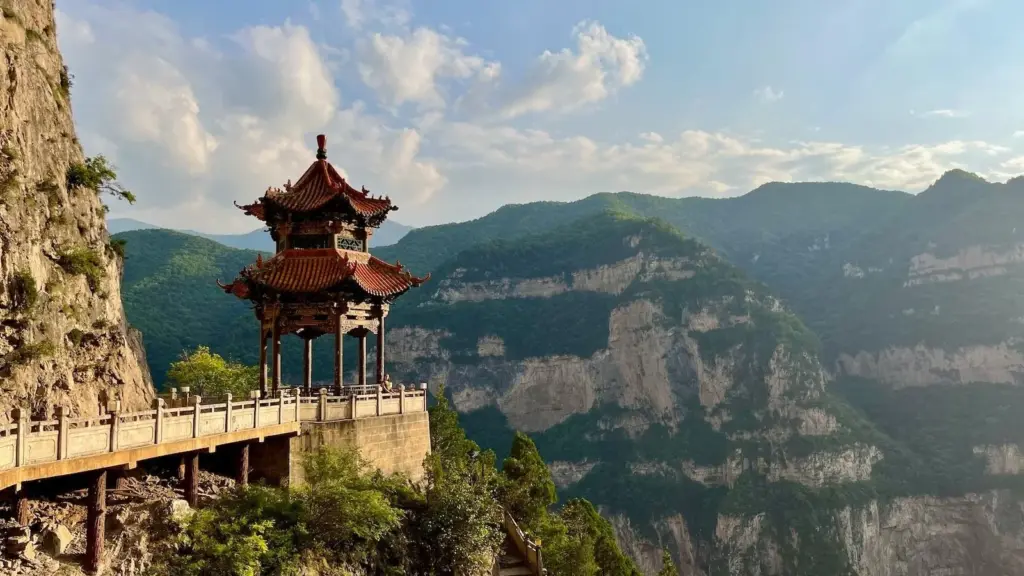
An Essential Guide to Visiting Mian Shan
In This Guide
- An Essential Guide to Visiting Mian Shan
- The Rich History and Legends of Mian Shan
- Main Highlights: What You Absolutely Can’t Miss
- Planning Your Visit: A Practical Guide
- Tickets: Prices, Booking, and Tips
- How to Get There: A Complete Transportation Guide
- Local Cuisine and Accommodation Nearby
- Frequently Asked Questions
- Final Thoughts on Your Trip
Nestled in the heart of Shanxi Province, Mian Shan (绵山) offers an enchanting escape into China’s rich tapestry of history and natural beauty. Just a stone’s throw from the ancient city of Pingyao, this tranquil mountain range invites travelers to explore its serene forest valleys, dramatic cliffs, and sacred temples. Unlike the bustling tourist hotspots that often define China’s landscape, Mian Shan remains a hidden gem—a place where the whispers of history intertwine with the rustling leaves and cascading waters.
A visit to Mian Shan is not merely a hike through stunning scenery; it’s a journey steeped in cultural significance. The mountain is the birthplace of the Qingming Festival, a time-honored celebration of ancestor remembrance. Here, the story of Jie Zitui, a loyal nobleman whose sacrifice inspired this festival, unfolds through intricate temple reliefs and serene tombs. As you wander the winding paths, you’ll encounter breathtaking views, cliffside shrines, and the ancient wisdom of Taoism—an invitation to reflect on the past while soaking in the beauty of the present.
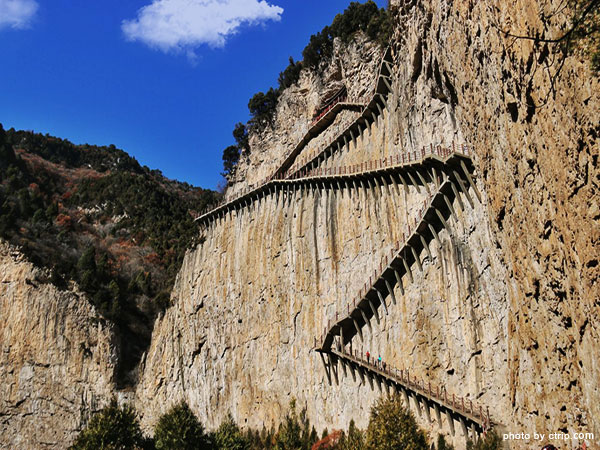
Mian Shan.
Whether you’re an avid hiker seeking adventure or a history buff eager to delve into China’s cultural heritage, Mian Shan caters to every interest. The well-maintained trails range from leisurely strolls suitable for families to exhilarating walks across hanging bridges, ensuring that every visitor leaves with memories etched in their hearts. With fewer crowds and an air of tranquility, Mian Shan beckons you to explore its depths, offering a unique and enriching experience far beyond the ordinary tourist path.
Prepare to immerse yourself in a world where nature and history coalesce, and let Mian Shan reveal the enchanting stories that have shaped this remarkable region. Your adventure awaits!
The Rich History and Legends of Mian Shan
Nestled in the heart of Shanxi Province, Mian Shan (绵山) is a treasure trove of history and legend, captivating visitors with its ancient allure and spiritual significance. This majestic mountain, situated near the historic town of Pingyao, is not only a breathtaking natural wonder but also a site steeped in cultural narratives that resonate deeply with China’s rich heritage.

Mian Shan.
A Historical Haven
Mian Shan has been revered as a sacred site since ancient times, known for its lush landscapes and towering cliffs. The mountain’s history is intertwined with the narratives of various dynasties, and it has long served as a spiritual sanctuary for Taoists and Buddhists alike.
One of the most significant historical figures associated with Mian Shan is Jie Zitui (介子推), a nobleman from the Spring and Autumn period. Jie is celebrated for his loyalty and selflessness, particularly his act of sacrificing his own flesh to save his starving lord. His tragic story inspired the Qingming Festival, also known as Tomb-Sweeping Day, which is observed in honor of ancestors and the memory of the deceased. At Jie Shen Temple and Jie Gong’s Tomb, visitors can explore intricate reliefs that depict Jie’s life, offering a poignant glimpse into ancient Chinese values of loyalty and sacrifice.
Legends of the Mountain
Mian Shan is also rich in legends that have been passed down through generations. One of the most enchanting tales involves the Sky Bridge, a cliffside walkway that seems to float above the clouds. Local lore suggests that this mystical pathway was once traversed by celestial beings who descended to earth to bless the mountain. On misty days, the bridge transforms into a scene straight out of a fairy tale, as if connecting the human realm with the heavens.
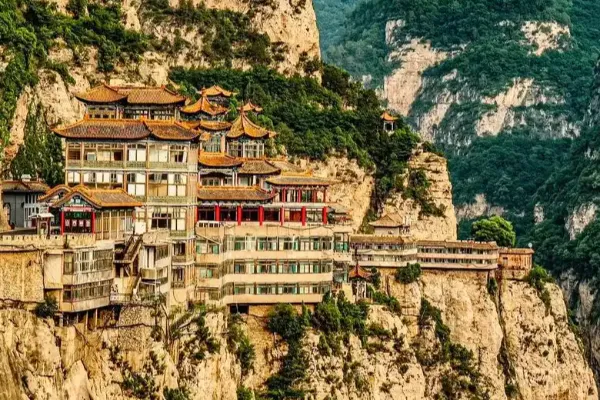
Mian Shan.
Another legend speaks of the Longtou Temple, named for its dragon-shaped lookout. It is said that the dragon’s mouth serves as a portal to the underworld, where the souls of the deceased navigate through the Eighteen Levels of Hell. The temple features vibrant sculptures that illustrate traditional beliefs about karma and the afterlife, making it a significant site for those interested in Buddhist teachings.
Spiritual Significance
Beyond its natural beauty, Mian Shan is a place of profound spiritual significance. The Daluo Palace, often referred to as the “Potala Palace of Shanxi,” is a vast Taoist complex that reflects the intricate relationship between nature and spirituality in Chinese culture. With its striking red walls and golden roofs, it invites visitors to explore Taoist principles and the reverence for the mountain as a source of enlightenment.
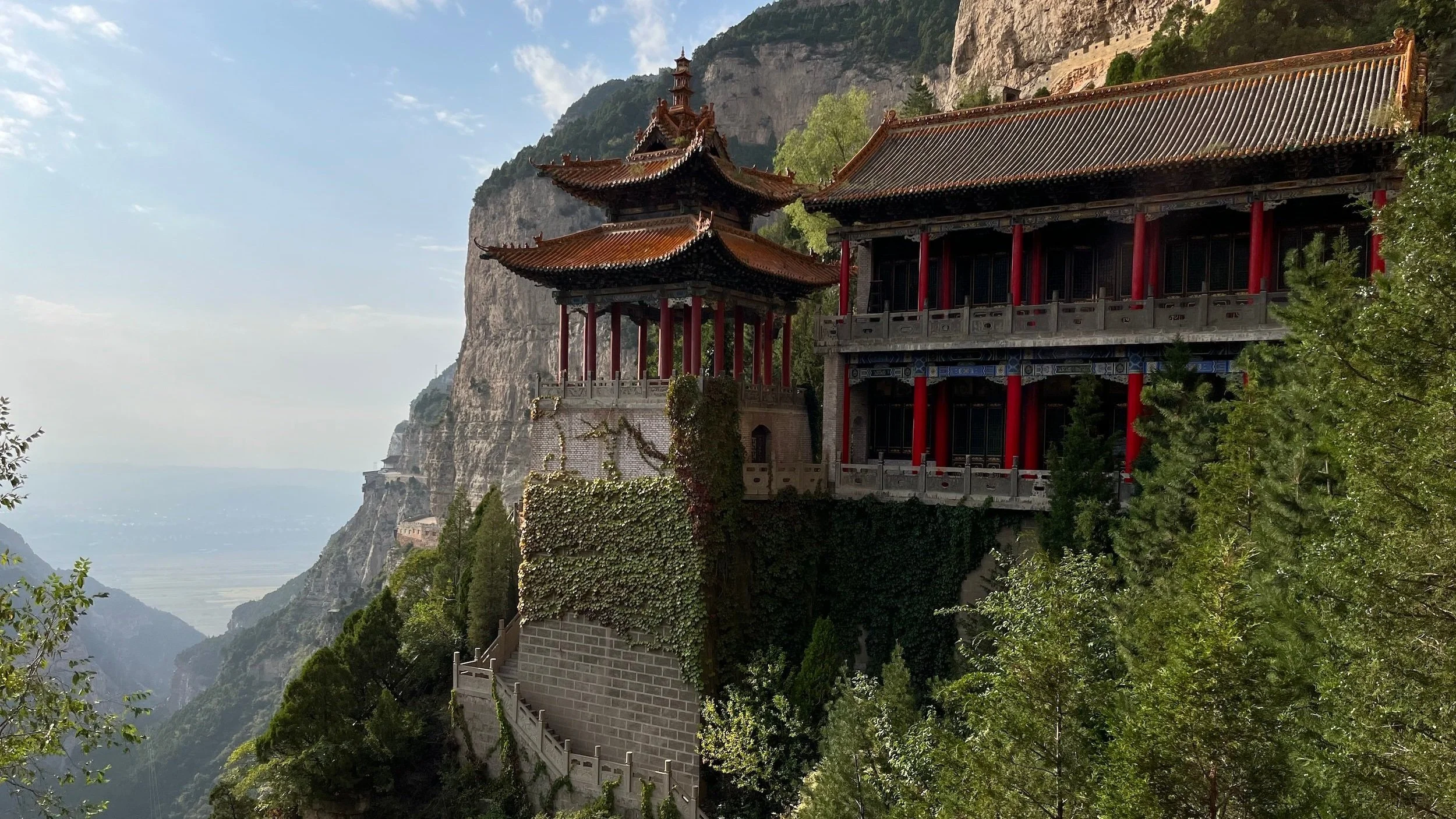
Mian Shan.
The mountain also serves as a backdrop for various cultural activities, including traditional Chinese tea ceremonies and meditative practices, allowing visitors to immerse themselves in the local way of life.
Conclusion
Whether you are drawn by the allure of its legends, the depth of its history, or the tranquility of its trails, Mian Shan promises a journey that transcends time. A visit to this sacred mountain not only enriches your understanding of Chinese culture but also offers an opportunity to connect with the spirit of a land steeped in ancient wisdom and beauty.
Main Highlights: What You Absolutely Can’t Miss
Mian Shan, or Mian Mountain, is a captivating destination that seamlessly blends cultural history with stunning natural beauty. Nestled in Shanxi Province, just a short trip from Pingyao, it offers a rich tapestry of experiences that cater to both history enthusiasts and nature lovers. Here’s a guide to the unmissable highlights you should explore during your visit to this enchanting area.
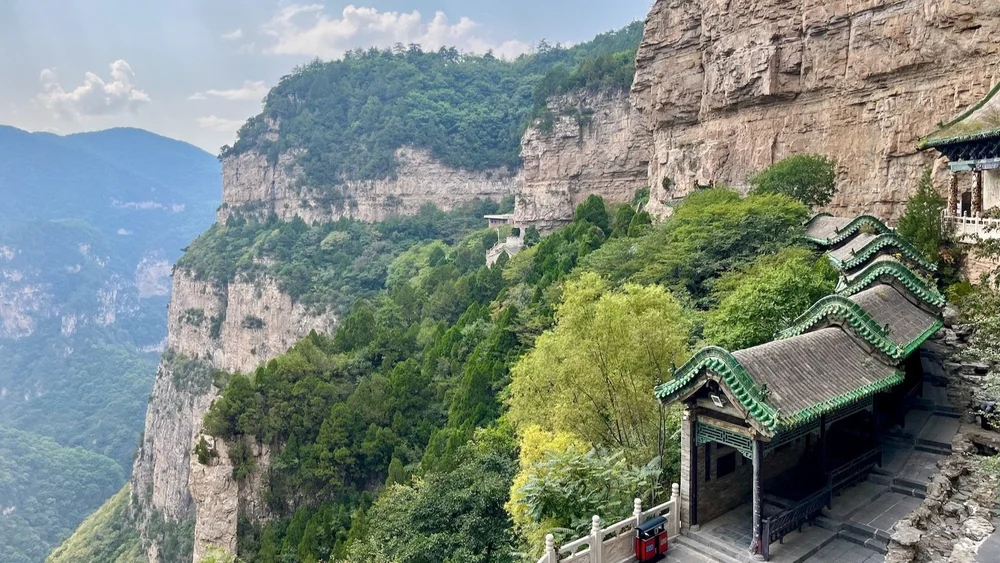
Mian Shan.
Shuitao Valley: A Family-Friendly Retreat
Begin your journey at Shuitao Valley, where a gentle 4 km trail meanders through shady trees and charming waterfalls. This scenic walk is perfect for families and casual hikers, taking about 2.5 hours round trip. For a shorter experience, turn back at the impressive Tow Dragons Playing with a Pearl statue, which allows for a delightful 30-minute jaunt.
Qixian Valley: Thrills and Adventure
For those seeking a bit of excitement, the Qixian Valley offers an adventurous walk with exhilarating hanging bridges and cliffside paths. The thrill of traversing these high-altitude walkways—often above rushing waters—will surely get your adrenaline pumping. Be sure to visit early in the day, as crowd control begins in the afternoon.
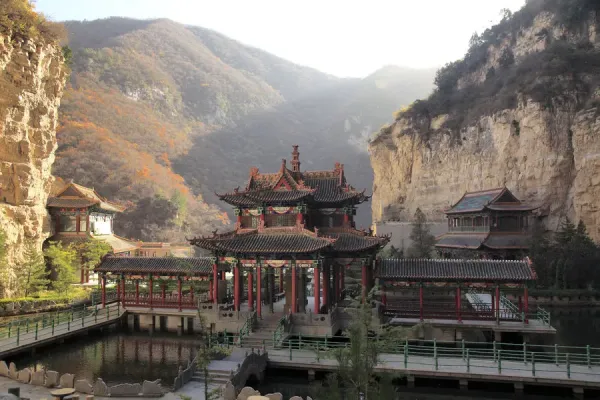
Mian Shan.
Jie Shen Temple & Jie Gong’s Tomb: The Birthplace of Qingming Festival
Delve into the roots of Chinese culture at the Jie Shen Temple, dedicated to Jie Zitui, a nobleman whose tale inspired the Qingming Festival. This temple features intricate reliefs and stories that reflect ancient Chinese values, making it a significant stop for history buffs. Adjacent to the temple is Jie Gong’s Tomb, a serene site that honors his legacy.
Zhengguo Temple & Yunfeng Temple: Cliffside Marvels
Don’t miss the Zhengguo Temple and Yunfeng Temple, which are perched dramatically on cliffs. Connected by a steep Z-shaped path, these temples house 15 preserved “flesh-body Buddhas,” offering a rare glimpse into Buddhist heritage. The breathtaking views and spiritual ambiance make this a must-see for visitors interested in religious history.
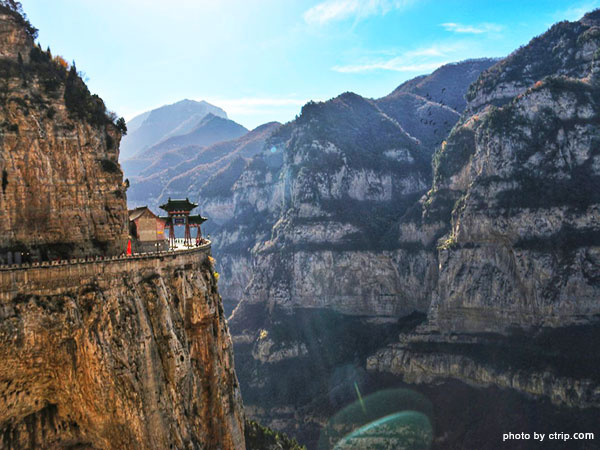
Mian Shan.
Sky Bridge: Walking Among the Clouds
The Sky Bridge is a thrilling 300-meter walkway that offers stunning vistas and a unique experience of walking through the clouds on misty days. Be cautious, as it may be closed during rainy weather, but on a clear day, the views are simply unforgettable.
Daluo Palace: A Taoist Gem
Referred to as the Potala Palace of Shanxi, the Daluo Palace is a vast 13-level Taoist complex intricately built into the mountainside. Allocate at least 1-2 hours to explore its grandeur, where tiered temples with red walls and golden roofs create a striking visual spectacle.
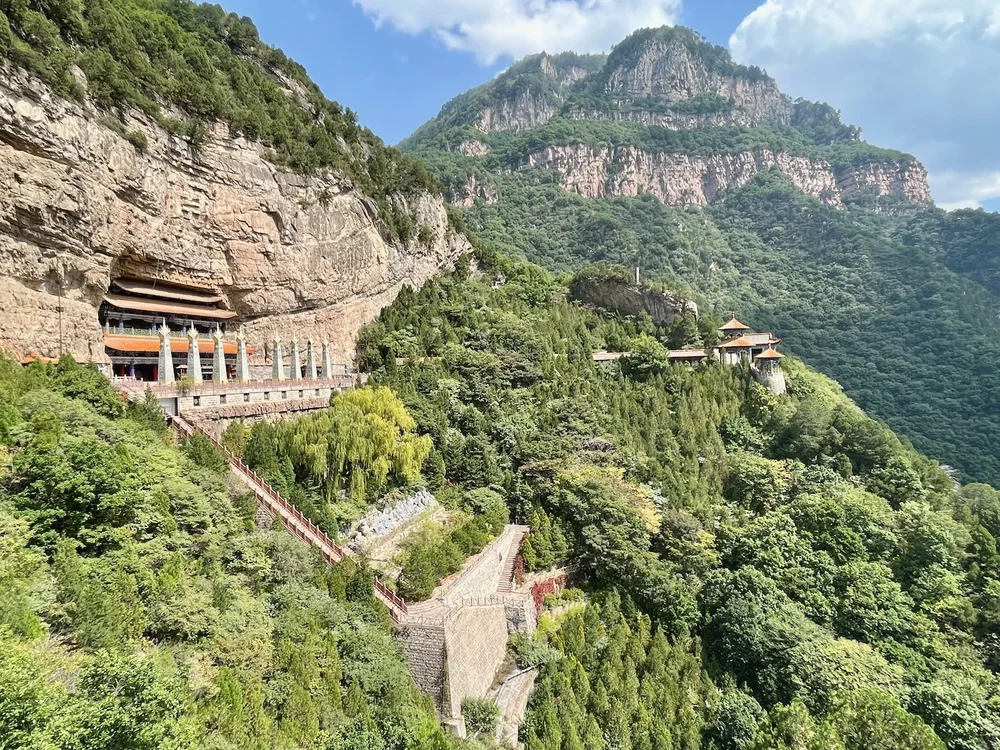
Mian Shan.
Longtou Temple: A Journey into the Afterlife
Finally, explore the Longtou Temple, featuring an underground palace that vividly presents the “Eighteen Levels of Hell.” This depiction of traditional Chinese beliefs about karma and the afterlife is both haunting and fascinating, offering a deeper understanding of the cultural psyche.
Planning Your Visit
Mian Shan is best experienced over a full day, beginning at the top and making your way down. Shuttle buses and cable cars are available to ease your journey, especially if you’re traveling with family or individuals with limited mobility.
Travel Tips
- Optimal Time to Visit: Spring and early summer are ideal for witnessing the waterfalls and lush scenery.
- Accessibility: While some areas have elevators, be prepared for a considerable amount of walking and climbing.
- What to Bring: Comfortable walking shoes, water, snacks, and mosquito repellent are essential for a pleasant outing.

Mian Shan.
Mian Shan stands as a testament to the rich cultural and natural tapestry of China, inviting you to uncover its secrets and stories. Whether you’re hiking through verdant valleys or reflecting in ancient temples, this hidden gem promises an unforgettable experience.
Planning Your Visit: A Practical Guide
Your Gateway to Mian Shan: Essential Travel Information
Mian Shan (绵山), a serene escape nestled in the verdant landscapes of Shanxi Province, is a treasure trove of cultural history and natural beauty. This guide will help you navigate your visit, ensuring a fulfilling experience that connects you with both the history and the breathtaking surroundings of this off-the-beaten-path destination.
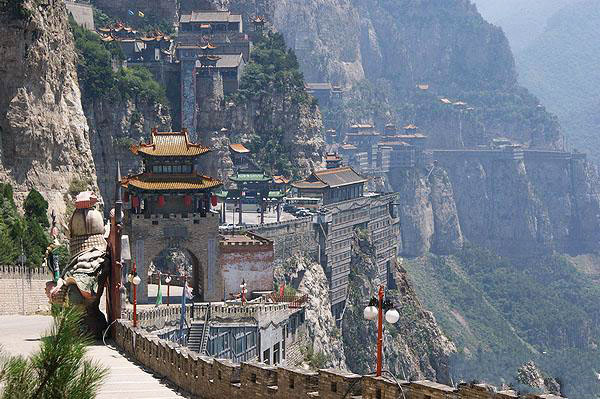
Mian Shan.
Getting There
From Pingyao:
– By Train: Take a high-speed train from Pingyao Ancient City Railway Station to Jiexiu Railway Station. The journey lasts approximately 20 minutes. From Jiexiu, a car ride to Mian Shan takes an additional 30–40 minutes.
– By Car: For a more flexible and time-saving option, consider hiring a private car. The total travel time is around 1 to 1.5 hours.
Opening Hours and Ticketing
- Opening Hours:
- Summer: 8:00 AM – 7:00 PM
- Winter: 8:30 AM – 6:00 PM
- Admission Fee: RMB 160 (approximately USD 22), which includes access to shuttle buses within the scenic area. Tickets can be purchased online through WeChat or at the entrance.
Duration of Visit
A full day (6–8 hours) is recommended to explore the main highlights of Mian Shan. Depending on your interests and pace, plan accordingly to make the most of your visit.
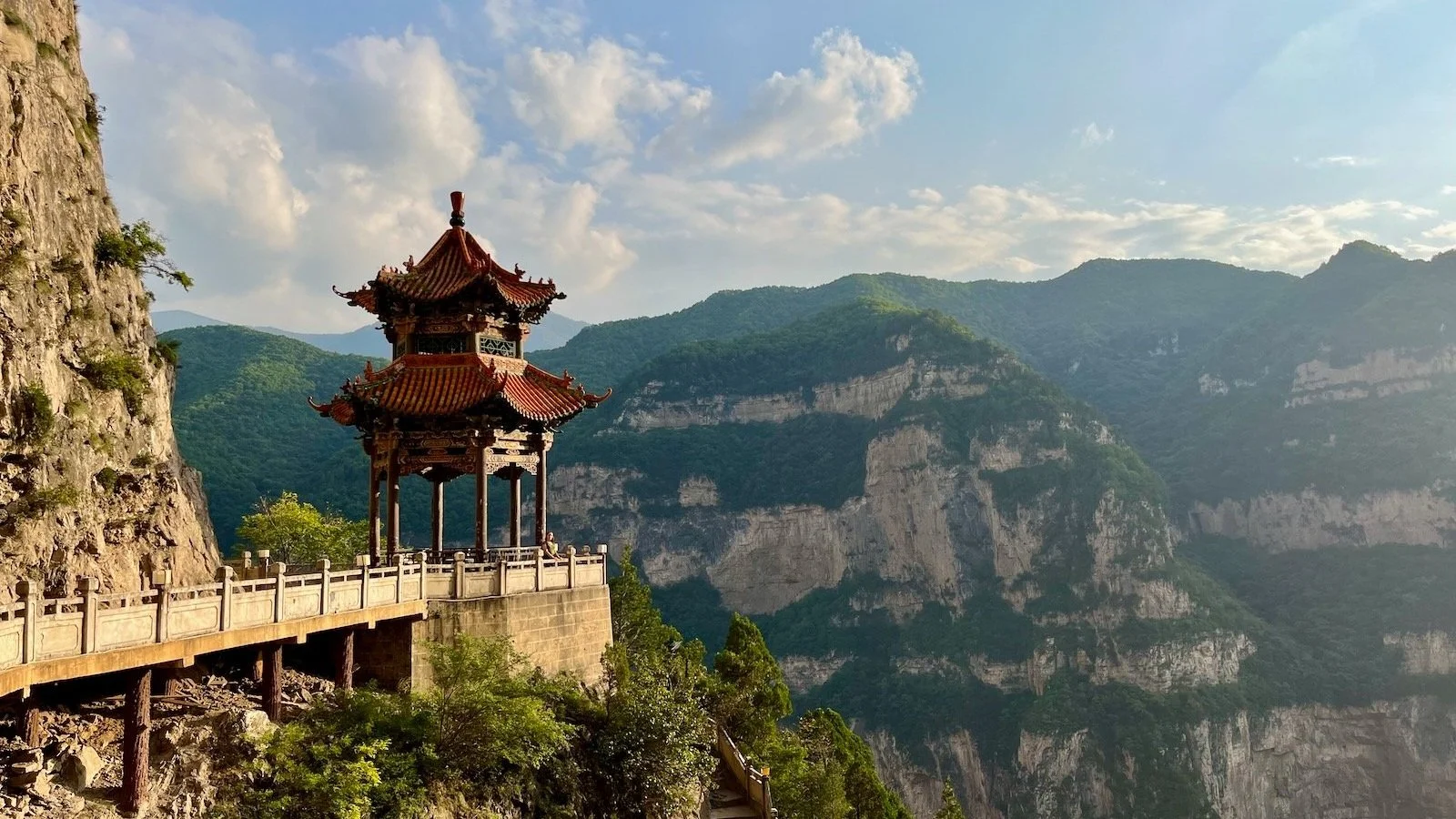
Mian Shan.
Highlights Not to Miss
- Shuitao Valley:
- A family-friendly, 4 km trail featuring small waterfalls and shaded trees. The round trip takes about 2.5 hours.
-
Turn back at the “Two Dragons Playing with a Pearl” statue for a shorter hike.
-
Qixian Valley:
-
Experience an exhilarating walk across hanging bridges and cliffside paths. This area is not suitable for those with mobility issues or small children.
-
Jie Shen Temple & Jie Gong’s Tomb:
-
Learn about the origins of the Qingming Festival, dedicated to Jie Zitui, a nobleman whose loyalty is celebrated in this poignant tale.
-
Zhengguo Temple & Yunfeng Temple:
-
Marvel at the cliffside temples connected by a steep Z-shaped path. Inside, discover preserved mummified monks, a fascinating aspect of Buddhist heritage.
-
Sky Bridge:
-
A thrilling 300-meter walkway that offers stunning views, especially on misty days when it feels like walking among the clouds.
-
Daluo Palace:
-
Often referred to as the “Potala Palace of Shanxi,” this impressive Taoist complex requires careful exploration, so allocate 1–2 hours to fully appreciate its architectural grandeur.
-
Longtou Temple:
- Visit the underground palace showcasing vivid sculptures of the “Eighteen Levels of Hell,” illustrating traditional Chinese views on karma and the afterlife.
Suggested Itineraries
For Families or Casual Hikers:
– Start at Shuitao Valley and enjoy a leisurely hike.
– Utilize the cable car to reach the top and explore the temples, then work your way down through Qixian Valley and the cliff temples.
– End your day at Daluo Palace and Longtou Temple.
For Adventure Seekers:
– Begin at Qixian Valley for an adrenaline-pumping experience.
– Visit Jie Shen Temple and Jie Gong’s Tomb before heading down to Shuitao Valley.
– Follow the same path as the family itinerary to finish your day.
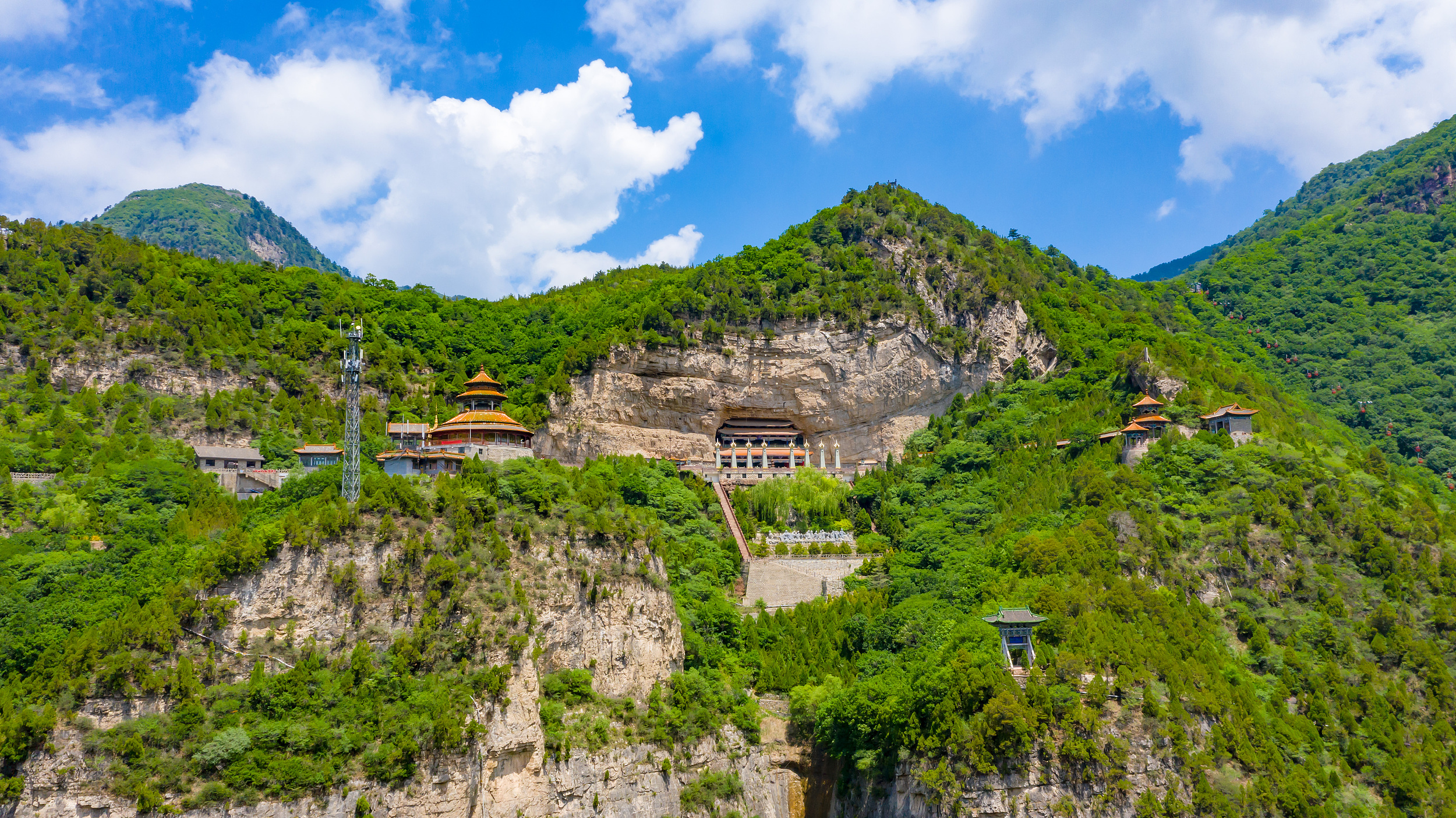
Mian Shan.
Travel Tips
-
Best Time to Visit: Mian Shan is most beautiful in spring and early summer when waterfalls and streams are at their peak. Late autumn and winter may provide a more subdued experience due to reduced water flow.
-
Crowd Levels: Enjoy a more peaceful visit, as Mian Shan tends to be less crowded even on weekends and holidays.
-
Accessibility: Note that many trails and highlights require significant walking and climbing. While there are some elevators and shuttles, the site is not particularly accommodating for those with limited mobility.
-
What to Pack: Wear sturdy walking shoes, bring water and snacks (available on-site but at a premium), and dress in layers. Don’t forget mosquito repellent for those hiking through the valleys.
Conclusion
Mian Shan offers a unique blend of natural beauty and cultural significance, making it a must-visit for travelers interested in exploring China’s rich heritage. With thoughtful planning, you can immerse yourself in the serene landscapes and historical narratives that define this enchanting destination. Enjoy your adventure!
Tickets: Prices, Booking, and Tips
When planning your visit to Mian Shan, it’s important to have a clear understanding of ticket prices, booking options, and essential tips to ensure a smooth and enjoyable experience. Here’s everything you need to know about tickets for this stunning cultural and natural destination.
Ticket Prices
- General Admission: RMB 160 (approximately USD 22 / SGD 30). This ticket includes access to shuttle buses within the scenic area, making it easy to navigate between the highlights without extensive walking.
Booking Options
- Online Booking: Tickets can be conveniently purchased online. Platforms like WeChat offer a seamless booking experience, allowing you to secure your entry ahead of time.
- On-Site Purchase: If you prefer spontaneity, tickets can also be purchased at the entrance of Mian Mountain. However, it’s advisable to arrive early, especially during weekends or holidays, to avoid any potential waiting time.
Tips for a Successful Visit
- Plan Your Timing:
- Operating Hours: Mian Mountain is open from 8:00 AM to 7:00 PM during the summer months and 8:30 AM to 6:00 PM in winter. Arriving early can help you beat any crowds and enjoy the serene atmosphere.
-
Best Seasons: The ideal time to visit is in spring and early summer when the waterfalls and streams are at their most vibrant. Late autumn and winter may leave some valleys looking dry.
-
Consider Mobility:
-
The terrain at Mian Mountain is varied, with many trails and stairs. While there are shuttles and elevators in certain areas, be prepared for significant walking and hiking. This site is not highly suitable for those with limited mobility.
-
What to Bring:
- Comfortable Footwear: Sturdy hiking shoes are a must, as you’ll be traversing uneven paths and climbing stairs.
- Water and Snacks: While food and beverages are available at some stops, prices can be higher. Bringing your own water and snacks will save you money and ensure you stay energized throughout the day.
-
Weather Preparedness: Dress in layers and consider bringing a light jacket, as the weather can change quickly in mountainous areas. Don’t forget mosquito repellent, especially if you plan to hike through the lush valleys.
-
Plan Your Route:
-
Mian Mountain is expansive, so having a strategy for your visit can enhance your experience. Starting from the top and working your way down is recommended, as it minimizes uphill walking and maximizes efficiency.
-
Crowd Management:
- One of the highlights of Mian Mountain is its relative tranquility compared to more tourist-heavy locations in Shanxi. You can enjoy your visit without the hustle and bustle, allowing for a more contemplative exploration of the beautiful landscapes and historic temples.
By keeping these details in mind, you’ll be well-prepared to make the most of your visit to Mian Shan, an extraordinary blend of nature and culture that promises to be a highlight of your journey through China.
How to Get There: A Complete Transportation Guide
Getting to Mian Shan: Your Essential Transportation Guide
Visiting Mian Shan (绵山) is a delightful way to immerse yourself in the stunning natural beauty and rich cultural history of Shanxi Province. Whether you’re planning to hike its serene trails or explore its ancient temples, getting there is straightforward. Here’s how you can make your journey seamless and enjoyable.
From Pingyao to Mian Shan
If you’re already in Pingyao, a UNESCO World Heritage Site, a day trip to Mian Shan is not only feasible but highly recommended. Here are your main transportation options:
- High-Speed Train
- Route: Depart from Pingyao Ancient City Railway Station to Jiexiu Railway Station.
- Duration: Approximately 20 minutes.
- Frequency: Trains run regularly throughout the day, ensuring flexibility in your travel schedule.
- Cost: Generally low, making it an economical choice.
Upon arriving at Jiexiu Railway Station, you will need to continue your journey to Mian Shan by car.
- Private Car Hire
- Duration: The drive from Jiexiu Railway Station to Mian Shan takes about 30-40 minutes.
- Benefits: Hiring a private car offers convenience and flexibility, allowing you to explore at your own pace. Many local accommodations in Pingyao can arrange this for you.
Driving to Mian Shan
If you prefer to drive yourself or have access to a rental car, Mian Shan is easily accessible by road:
- Route: Follow the G108 national highway from Pingyao, heading towards Jiexiu City.
- Distance: Approximately 60 kilometers (37 miles).
- Travel Time: Expect about 1 to 1.5 hours depending on traffic conditions.
Local Transportation at Mian Shan
Once you arrive at Mian Shan, navigating the scenic area is convenient:
- Shuttle Buses: Inside the scenic area, shuttle buses are available to transport visitors between key attractions. This is especially useful for those who want to minimize walking.
- Cable Cars: For a more leisurely ascent, cable cars are available at select points, providing stunning aerial views of the area.
- Walking Paths: Many of the highlights are accessible via well-maintained walking paths, making it easy to explore the natural beauty at your own pace.
Travel Tips
- Best Time to Visit: While Mian Shan can be visited year-round, the scenery is particularly breathtaking in spring and early summer when waterfalls and streams are at their fullest.
- Tickets: Entrance tickets can be purchased online or at the entrance. Prices are around RMB 160 (approximately USD 22).
- Plan Your Day: Allocate 6-8 hours for exploring the main sights, especially if you plan to hike and visit multiple temples.
- What to Bring: Pack sturdy walking shoes, water, snacks, and a light jacket. Mosquito repellent is also recommended during warmer months.
Conclusion
Mian Shan is a hidden gem that combines the beauty of nature with significant cultural history. With the right transportation plan, you can enjoy a hassle-free adventure to this tranquil destination. Whether you opt for the efficient high-speed train or the flexibility of a private car, your journey to Mian Shan promises to be as memorable as the experiences that await you there. Happy travels!
Local Cuisine and Accommodation Nearby
When exploring the serene beauty and rich cultural tapestry of Mian Shan, indulging in local cuisine and finding the perfect place to rest is essential for a fulfilling journey. Here’s a guide to the culinary delights and comfortable accommodations that await you in this enchanting region.
Culinary Delights Near Mian Shan
- Local Shanxi Noodles (刀削面, Dāoxiāomiàn)
-
A must-try dish when in the Shanxi Province. These hand-sliced noodles are renowned for their chewy texture and are typically served in a rich broth with various toppings such as beef, vegetables, and chili oil. Look for local eateries in Jiexiu City where you can savor this authentic dish.
-
Yangrou Paomo (羊肉泡馍)
-
This hearty lamb soup with crumbled bread is a specialty of the region. The warm, flavorful broth, combined with tender lamb, makes for a satisfying meal after a day of hiking. Restaurants near the mountain often serve this dish, perfect for restoring your energy.
-
Shanxi Aged Vinegar (山西陈醋)
-
Known as one of the best vinegars in China, this local condiment is essential for enhancing your meals. Many dishes served in the area are accompanied by this unique vinegar, which adds a rich, tangy flavor to everything from dumplings to stir-fries.
-
Grilled Dishes and Street Snacks
- As you stroll through Jiexiu, make sure to sample the street food scene. From grilled skewers of meat to crispy spring rolls, local vendors offer a variety of snacks that are perfect for a quick bite before heading back to the mountain.
Where to Stay
- Mian Shan Resort Hotel
-
Nestled close to the mountain, this resort offers comfortable accommodations with stunning views of the surrounding landscape. The hotel features amenities such as a restaurant serving local cuisine, a spa, and guided tours to the nearby attractions.
-
Jiexiu Jinding Business Hotel
-
This modern hotel is located in Jiexiu City and provides a convenient base for your Mian Shan adventure. With well-appointed rooms, free Wi-Fi, and a dining area specializing in Shanxi dishes, it’s a great choice for those looking for comfort and accessibility.
-
Pingyao Ancient Town Guesthouses
-
If you prefer a more traditional experience, consider staying in one of the charming guesthouses in Pingyao. Many of these establishments are set in historical buildings and offer a cozy atmosphere, as well as home-cooked meals that highlight local flavors. The guesthouses often provide transportation options to Mian Shan, making your travel seamless.
-
Homestays in Jiexiu
- Experience local life by staying in a homestay. Many families in Jiexiu open their homes to travelers, providing not only a place to sleep but also authentic meals and a glimpse into daily life in this picturesque area. Look for listings that offer meals prepared with fresh, local ingredients.
Conclusion
Mian Shan is not just a feast for the eyes with its breathtaking landscapes and ancient temples; it is also a paradise for food lovers and those seeking cultural immersion. Whether you’re savoring the flavors of Shanxi or resting in charming accommodations, every moment spent here will deepen your appreciation for this remarkable region of China. Embrace the tranquility, indulge your palate, and let the local hospitality enhance your journey.
Frequently Asked Questions
Frequently Asked Questions about Mian Shan
1. What are the main highlights of Mian Shan?
Mian Shan is renowned for its stunning natural beauty and rich cultural history. Key highlights include:
– Shuitao Valley: A family-friendly trail featuring small waterfalls and shaded paths.
– Qixian Valley: An adventurous area with hanging bridges and cliffside walks, perfect for thrill-seekers.
– Jie Shen Temple & Jie Gong’s Tomb: The birthplace of the Qingming Festival, dedicated to Jie Zitui, a nobleman celebrated for his loyalty.
– Zhengguo Temple and Yunfeng Temple: Unique cliffside temples housing preserved mummified monks.
– Sky Bridge: A breathtaking 300-meter cliff walkway offering thrilling views.
– Daluo Palace: A large Taoist complex, often referred to as the “Potala Palace of Shanxi”.
– Longtou Temple: Features vivid sculptures depicting the “Eighteen Levels of Hell”.
2. How do I get to Mian Shan from Pingyao?
To reach Mian Shan from Pingyao, you can:
– Take a high-speed train from Pingyao Ancient City Railway Station to Jiexiu Railway Station (approximately 20 minutes), followed by a 30-40 minute taxi or shuttle ride.
– For flexibility and convenience, consider hiring a private car, which takes around 1 to 1.5 hours each way.
3. What is the best time to visit Mian Shan?
The ideal time to visit Mian Shan is during spring and early summer when the waterfalls and streams are most vibrant. The natural scenery can be less impressive in dry months, particularly in autumn and winter.
4. Is Mian Shan suitable for families and visitors with limited mobility?
Mian Shan offers a variety of experiences that can cater to families, particularly in areas like Shuitao Valley. However, many highlights involve extensive walking, steep stairs, and cliff paths, which may pose challenges for visitors with limited mobility. While there are elevators and shuttle buses in certain areas, it’s advisable to plan accordingly.
5. What should I pack for a day trip to Mian Shan?
When visiting Mian Shan, consider packing:
– Sturdy walking shoes: Essential for navigating trails and temple paths.
– Water and snacks: Food and drink options are available on-site, but prices can be higher.
– A light jacket: Weather can change, especially in the mountains.
– Mosquito repellent: Particularly important if you plan to hike through forests and valleys.
6. How long should I plan to spend at Mian Shan?
A full day (approximately 6-8 hours) is recommended to explore the main sites of Mian Shan. You can choose between a more relaxed route or a more active hiking path, depending on your interests and stamina.
7. Are there any ticket options available?
Tickets for Mian Shan are priced at approximately RMB 160 (USD 22 / SGD 30), which includes access to shuttle buses within the scenic area. You can purchase tickets online via WeChat or at the entrance.
8. What are the opening hours for Mian Shan?
Mian Shan is open from 8:00 AM to 7:00 PM during the summer months and from 8:30 AM to 6:00 PM in winter. It’s advisable to arrive early to maximize your time exploring the area.
Final Thoughts on Your Trip
As you conclude your journey through the enchanting landscapes of Mian Shan, you carry with you a treasure trove of memories steeped in the rich tapestry of Chinese history and culture. This hidden gem of Shanxi Province offers an extraordinary blend of stunning natural beauty and deeply rooted traditions that resonate with every step you take along its tranquil trails and majestic temples.
Unforgettable Highlights
From the serene Shuitao Valley, where the gentle sound of waterfalls accompanies your stroll, to the exhilarating heights of the Sky Bridge, Mian Shan captivates the adventurous spirit within you. The sacred Jie Shen Temple, with its homage to Jie Zitui, invites reflection on loyalty and sacrifice, while the fascinating cliffside temples challenge your sense of wonder and appreciation for ancient craftsmanship.
A Unique Experience
Unlike the bustling tourist hotspots, Mian Shan allows you to immerse yourself in a more peaceful experience. You can wander freely, soaking in the lush surroundings and discovering the stories embedded within each temple. The site’s rarity of crowds ensures that you can connect with nature and history on your own terms, making it ideal for those seeking a deeper understanding of China’s cultural heritage.
Final Thoughts
As you make your way back to Pingyao or continue your travels across China, remember that Mian Shan is more than just a destination; it’s a journey into the essence of Chinese philosophy and spirituality. Whether you came for the hiking, the history, or the breathtaking views, you leave with the knowledge that you’ve touched a piece of China that remains largely untouched by time.
So, pack your bags and prepare for your next adventure, knowing that the serene beauty and profound tales of Mian Shan will forever linger in your heart, inspiring you to seek out more of China’s hidden wonders. Safe travels!